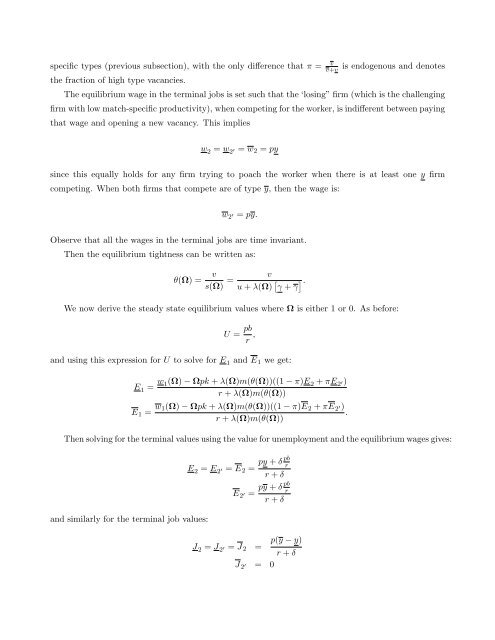Unemployment cycles
WP201526
WP201526
Create successful ePaper yourself
Turn your PDF publications into a flip-book with our unique Google optimized e-Paper software.
specific types (previous subsection), with the only difference that π =<br />
the fraction of high type vacancies.<br />
v<br />
v+v<br />
is endogenous and denotes<br />
The equilibrium wage in the terminal jobs is set such that the ‘losing” firm (which is the challenging<br />
firm with low match-specific productivity), when competing for the worker, is indifferent between paying<br />
that wage and opening a new vacancy. This implies<br />
w 2 = w 2 ′ = w 2 = py<br />
since this equally holds for any firm trying to poach the worker when there is at least one y firm<br />
competing. When both firms that compete are of type y, then the wage is:<br />
w 2 ′ = py.<br />
Observe that all the wages in the terminal jobs are time invariant.<br />
Then the equilibrium tightness can be written as:<br />
θ(Ω) =<br />
v<br />
s(Ω) =<br />
v<br />
u + λ(Ω) [ γ + γ ].<br />
We now derive the steady state equilibrium values where Ω is either 1 or 0. As before:<br />
U = pb<br />
r ,<br />
and using this expression for U to solve for E 1 and E 1 we get:<br />
E 1 = w 1(Ω) − Ωpk + λ(Ω)m(θ(Ω))((1 − π)E 2 + πE 2 ′)<br />
r + λ(Ω)m(θ(Ω))<br />
E 1 = w 1(Ω) − Ωpk + λ(Ω)m(θ(Ω))((1 − π)E 2 + πE 2 ′)<br />
.<br />
r + λ(Ω)m(θ(Ω))<br />
Then solving for the terminal values using the value for unemployment and the equilibrium wages gives:<br />
E 2 = E 2 ′ = E 2 =<br />
E 2 ′ =<br />
pb<br />
py + δ<br />
r<br />
r + δ<br />
pb<br />
py + δ<br />
r<br />
r + δ<br />
and similarly for the terminal job values:<br />
J 2 = J 2 ′ = J 2 =<br />
p(y − y)<br />
r + δ<br />
J 2 ′ = 0


